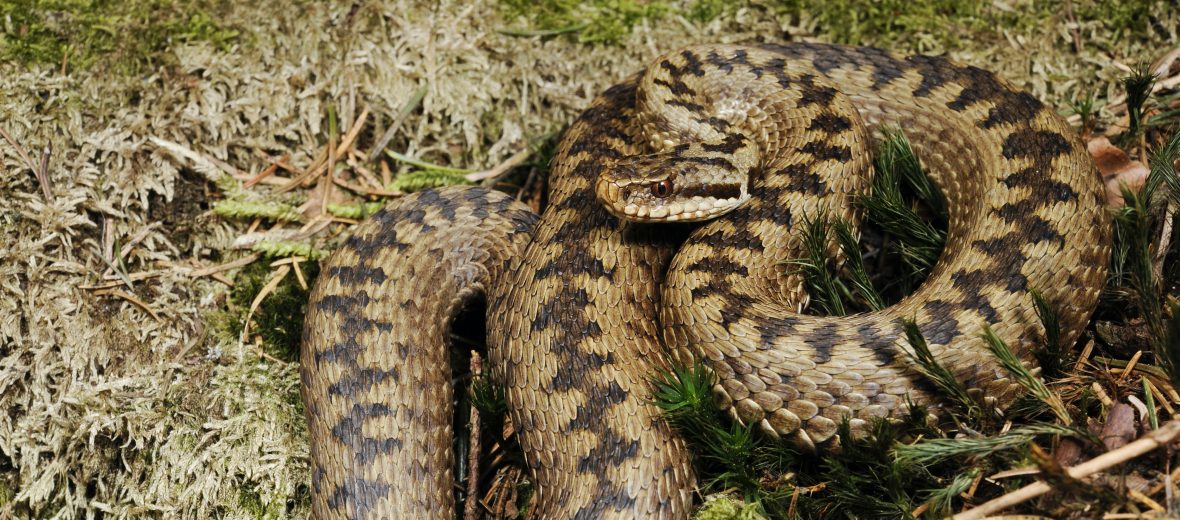
The common European adder, aka marlies, prags, bardas, common viper, common European viper, European viper, European common viper, northern viper, crossed viper, adder, common adder, cross adder, common cross adder, and European adder, (talk about an identity crisis) can be found throughout Europe and into Asia. They tolerate a variety of habitats, including: moors, meadows, edges of woods, chalky downs, rocky hillsides, sandy heaths, rough commons, sunny glades, clearings, bushy slopes, hedgerows, dumps, stone quarries, and coastal dunes. Even though they face the threats of habitat loss, at the hands of housing and commercial developments, agriculture, and aquaculture; ecosystem modifications; hunting; and trapping, these snakes are still listed as Least Concern by the IUCN. But their populations are decreasing.
First the Stats…
Scientific name: Vipera berus
Weight: Up to 3.53 ounces
Length: Up to 21.65 inches
Lifespan: Up to 15 years
Now on to the Facts!
1.) Common European adders are not particularly dangerous, nor are they too terribly aggressive. But they will bite if threatened, accidentally stepped on, or mishandled.
2.) In the northern parts of their range, they tend to be more diurnal (active during the day). In the southern reaches of their range, they tend to be more nocturnal (active at night).
3.) These serpents are primarily terrestrial (spend their lives on the ground). But they can climb well, if needed.
4.) The common European adder is, like other snakes, solitary and only comes together to breed, or seek shelter and brumate (hibernation for reptiles) during colder winter months.
5.) A group of snakes, although uncommonly seen, is called a bed, den, knot, nest, or pit.
But wait, there’s more on the common European adder!
6.) Not being terribly aggressive, these snakes will usually flee at the first hint of danger. They only tend to bite when absolutely necessary.
7.) Pregnant females will let their presence be known via a long, loud hissing sound.
Did you know…?
There are approximately 8 different antivenoms produced to combat a bite from these snakes. Typically only small children, elderly individuals, and small pets are at risk of death from a bite.
8.) The effects of a common European adder bite can be intense pain, swelling, a tingling sensation, tenderness, inflammation, lymphangitic lines, and bruising can also occur, & the entire limb can become bruised and swollen within 24-hours. Lasting effects of a bite can linger for up to a year!
9.) Nausea, vomiting, retching, abdominal colic, diarrhea, sweating, fever, vasoconstriction, tachycardia, lightheadedness, loss of consciousness, blindness, shock, angioedema of the face, lips, gums, tongue, throat, and epiglottis, urticaria, and bronchospasms may also occur.
10.) Mice, rats, voles, shrews, weasels, moles,amphibians, lizards, birds, and bird eggs are all on the menu.
But wait, there’s still more on the common European adder!
11.) These snakes are, like many other snakes, polygynous (males mate with multiple females).
12.) Mating occurs in spring and females mate approximately every 2 years.
Did you know…?
The word ‘adder’ hails from nædre, an Old English word that had the generic definition of serpent in the older forms of numerous Germanic languages.
13.) Courtship entails a side-by-side parallel ‘flowing’ behavior, tongue flicking along the back, and rapid lashing of their tail.
14.) Males battle 1 another for breeding rights. The battle is often called an adder dance. This involves flowing, rising up and trying to push the other down to the ground. The loser leaves and the winner gets the girls.
15.) Females undergo up to a 4 month gestation (pregnancy) that yields up to 20 live young.
But wait, there’s still a little more on the common European adder!
16.) Neonates (young snakes) are born precocial (self sufficient) and fully loaded with venom.
17.) Adders, in general, have been a part of folklore in Britain as well as other European countries.
18.) Birds of prey, smooth snakes, foxes, and badgers all prey on these serpents.
Now a Short Common European Adder Video!
Be sure to share & comment below! Also, check out the Critter Science YouTube channel. Videos added regularly!
Want to suggest a critter for me to write about? Let me know here.
Photo credit: Benny Trapp



